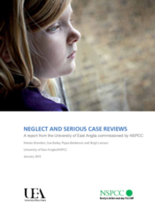This study provides a new contribution to our learning about neglect by exploring the circumstances in which neglect can be catastrophic and have a fatal or seriously harmful outcome for a child. It provides a systematic analysis of neglect in serious case reviews (local multi-agency reviews of child deaths or serious injury where abuse or neglect is known or suspected) in England, between 2003 and 2011. It draws on anonymised research information from over 800 cases from the four government commissioned national biennial analyses carried out by the authors, offering further analysis of the neglect cases that formed part of the most recent biennial analysis (Brandon et al 2012).
While this examination of neglect in serious case reviews provides important new learning, it is essential to be clear about the limitations of the study. Serious case reviews are not a reflection of typical child protection practice. The constellation of neglect-related events and characteristics that came together in these cases to produce an outcome of fatality or grave injury cannot be distilled into a check list of risk factors that predict such an outcome. In most cases with similar characteristics, a child will not come to such catastrophic harm. Yet there is learning here about how risks of harm accumulate and combine and the points at which intervention might successfully have helped to contain these risks. The learning is as important for children known to universal services, where they do not see a social worker, as for children with known child protection risks.
©University of East Anglia/NSPCC

